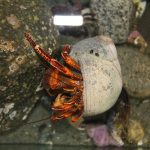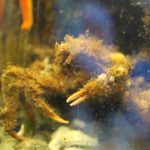Vancouver Island has many areas for sport fishing of Crustaceans and you will not be disappointed. I love going out to get my own crabs and prawns. I used to go out at low night tides towing a small skiff behind me, clam rake in hand with a flashlight.
Amphipods
 Amphipoda is an order of Crustaceans with no carapace and laterally compressed bodies. Amphipods range in size from 1 to over 300 mm and are, for the most part, scavengers. There are more than 9,000 amphipod species so far described. Read More….
Amphipoda is an order of Crustaceans with no carapace and laterally compressed bodies. Amphipods range in size from 1 to over 300 mm and are, for the most part, scavengers. There are more than 9,000 amphipod species so far described. Read More….
Barnacles
 Barnacle is the common name of the sedentary crustacean animals of the subclass Cirripedia. Barnacles are totally marine and attach themselves to the substrate by means of an adhesive produced by a cement gland and then secrete a shell of limestone plates around themselves. Read More….
Barnacle is the common name of the sedentary crustacean animals of the subclass Cirripedia. Barnacles are totally marine and attach themselves to the substrate by means of an adhesive produced by a cement gland and then secrete a shell of limestone plates around themselves. Read More….
Coonstripe Shrimp
 Coonstripe shrimp are among the relatively few animals that start out life as a male and later transform into a female for the rest of their lifetime. Although some Coonstripe Shrimp start out as females and remain that way for life. Read More….
Coonstripe shrimp are among the relatively few animals that start out life as a male and later transform into a female for the rest of their lifetime. Although some Coonstripe Shrimp start out as females and remain that way for life. Read More….
Dungeness Crabs
 As a predator, the Dungeness crab eats clams, mussels, crabs, and other crustaceans as well as some small fish. Crabs pursue prey more actively at night, tending to bury themselves in the sand during the day. When moving along the sea bottom, these crabs find and capture prey by probing the sand with their legs or claws. Read More….
As a predator, the Dungeness crab eats clams, mussels, crabs, and other crustaceans as well as some small fish. Crabs pursue prey more actively at night, tending to bury themselves in the sand during the day. When moving along the sea bottom, these crabs find and capture prey by probing the sand with their legs or claws. Read More….
Hermit Crabs
 The hermit crabs are land or water-dwelling crustaceans. Unlike true crabs, hermit crabs have soft, vulnerable abdomens. For protection from predators, many hermit crabs seek out abandoned shells, usually snail shells to live in. Read More….
The hermit crabs are land or water-dwelling crustaceans. Unlike true crabs, hermit crabs have soft, vulnerable abdomens. For protection from predators, many hermit crabs seek out abandoned shells, usually snail shells to live in. Read More….
Isopods
 The Isopod Ligia occidentalis has a flat, mottled dark grayish-green segmented body, 12 legs, a short forked tail, and two long searching antennae. As you can see in the photos, these antennae are almost as long as their bodies, which are about 2.5 cm. Read More….
The Isopod Ligia occidentalis has a flat, mottled dark grayish-green segmented body, 12 legs, a short forked tail, and two long searching antennae. As you can see in the photos, these antennae are almost as long as their bodies, which are about 2.5 cm. Read More….
Longhorn Decorator Crab
 The longhorn decorator crab is a very common sight on the Pacific Northwest coast. Their shell or carapace is about 4.5 cm wide at the adult stage. You can find the longhorn decorator crab from Alaska to Mexico with very large populations on the south coast. Read More….
The longhorn decorator crab is a very common sight on the Pacific Northwest coast. Their shell or carapace is about 4.5 cm wide at the adult stage. You can find the longhorn decorator crab from Alaska to Mexico with very large populations on the south coast. Read More….
Mole Crabs
 Pacific Mole Crabs, (Emerita analoga) live along sandy beaches on the west coast of North America, usually buried in the sand with only the breathing antennae sticking out. They are common along the California Coast but do show up on our West Coast Vancouver Island sandy beaches occasionally, they usually arrive as larvae by riding the northern currents. Read More….
Pacific Mole Crabs, (Emerita analoga) live along sandy beaches on the west coast of North America, usually buried in the sand with only the breathing antennae sticking out. They are common along the California Coast but do show up on our West Coast Vancouver Island sandy beaches occasionally, they usually arrive as larvae by riding the northern currents. Read More….
Mudflat Crabs
 The Mud Flat crabs can be found throughout the Pacific Northwest coastal region, including all of Vancouver Island. When approached this tiny crustacean will rear up on its hind legs, ready to do battle. At low tide, the Mud Flat Crabs can be found wandering about the island’s mudflats searching for bits of plants or animals to eat. Read More….
The Mud Flat crabs can be found throughout the Pacific Northwest coastal region, including all of Vancouver Island. When approached this tiny crustacean will rear up on its hind legs, ready to do battle. At low tide, the Mud Flat Crabs can be found wandering about the island’s mudflats searching for bits of plants or animals to eat. Read More….
Northern Kelp Spider Crab
 The Northern Kelp Spider Crabs can grow fairly large. This species seems to use less decoration than other spider crabs do. It has two rows of hooked setae just behind its rostrum, to which it sometimes attaches algae or kelp, etc. Unlike other decorator crabs, the items it attaches are usually food to eat later. Read More….
The Northern Kelp Spider Crabs can grow fairly large. This species seems to use less decoration than other spider crabs do. It has two rows of hooked setae just behind its rostrum, to which it sometimes attaches algae or kelp, etc. Unlike other decorator crabs, the items it attaches are usually food to eat later. Read More….
Prawns
 Prawns are commercially harvested in traps deployed on long lines commonly from 50 meters to 150 meters deep. Prawn traps vary in size, can be either oblong or cylindrical, and feature about 2 or 3 funnel-shaped openings each. These baited traps are laid out along a bottom line with the position of the traps marked with surface buoys. Read More….
Prawns are commercially harvested in traps deployed on long lines commonly from 50 meters to 150 meters deep. Prawn traps vary in size, can be either oblong or cylindrical, and feature about 2 or 3 funnel-shaped openings each. These baited traps are laid out along a bottom line with the position of the traps marked with surface buoys. Read More….
Puget Sound King Crab
 The Puget Sound King Crab is also known as the box crab. They are not very common in the Pacific Northwest but occasionally, one comes up in a trap. They are amazing crabs to see, almost look like a monster from some horror movie, but l find them to be beautiful to look at. Read More….
The Puget Sound King Crab is also known as the box crab. They are not very common in the Pacific Northwest but occasionally, one comes up in a trap. They are amazing crabs to see, almost look like a monster from some horror movie, but l find them to be beautiful to look at. Read More….
Purple Shore Crab
 Purple shore crabs live in the shallow intertidal waters of the Pacific Northwest. They can be found in water less than 1 meter deep. They prefer rocky coastlines where they can hide under the rocks. Purple Shore Crabs are omnivores who feed on algae, and live prey and will scavenge dead prey. They, in turn, are eaten by various animals and birds. Read More….
Purple shore crabs live in the shallow intertidal waters of the Pacific Northwest. They can be found in water less than 1 meter deep. They prefer rocky coastlines where they can hide under the rocks. Purple Shore Crabs are omnivores who feed on algae, and live prey and will scavenge dead prey. They, in turn, are eaten by various animals and birds. Read More….
Red Rock Crab
 The red rock crab also called red crab or rock crab is a close relative to the Dungeness crab. You will have a hard time trying to find this species of crabs in stores or restaurants because red rock crabs are deemed too small for commercial fishery. Read More….
The red rock crab also called red crab or rock crab is a close relative to the Dungeness crab. You will have a hard time trying to find this species of crabs in stores or restaurants because red rock crabs are deemed too small for commercial fishery. Read More….
Slender decorator Crabs
 The slender decorator Crab is quite abundant here on the Pacific Northwest coast, you can see them crawling all over the bottom at low tide, and they are just fascinating to observe as they go about the business of being crabs. Read More….
The slender decorator Crab is quite abundant here on the Pacific Northwest coast, you can see them crawling all over the bottom at low tide, and they are just fascinating to observe as they go about the business of being crabs. Read More….
Squat Lobster
 Squat lobsters are small and colourful creatures that are always cool to see. They range in size from less than two and a half centimetres up to ten centimetres, depending upon the species. Squat lobsters come with ten legs. The first pair of legs are very long and contain claws. The first ones are quite small and used to clean the gills, the second set is long and is armed with claws. the three pairs of legs after that are used for walking. Read More….
Squat lobsters are small and colourful creatures that are always cool to see. They range in size from less than two and a half centimetres up to ten centimetres, depending upon the species. Squat lobsters come with ten legs. The first pair of legs are very long and contain claws. The first ones are quite small and used to clean the gills, the second set is long and is armed with claws. the three pairs of legs after that are used for walking. Read More….

When you see a crab scurrying away, you lightly step on it and slide the clam rake under your foot to hold the crab to your foot. You swing your foot over your skiff, holding the crab to it with the rake, and then you let the crab fall into the boat. The hand didn’t get wet and the crab did not pinch you.
People often mistake empty Dungeness shells strewn along beaches for dead crabs. Crabs shed and grow new shells regularly as part of their growth process. The old shell splits at the back and along the sides, so the crab can back out. The shell the crab leaves behind is an almost intact replica of the crab.
The hermit crab is a land or water-dwelling crustacean. Unlike true crabs, hermit crabs have soft, vulnerable abdomens. For protection from predators, many hermit crabs seek out abandoned shells, usually snail shells to live in.
The mudflat crab can be found throughout the Pacific Northwest, including all of Vancouver Island. When approached this tiny crustacean will rear up on its hind legs, ready to do battle.
